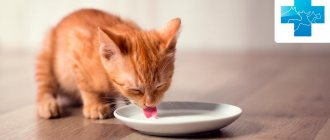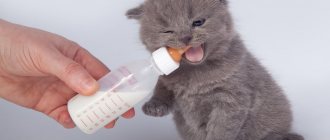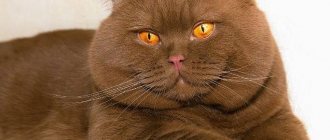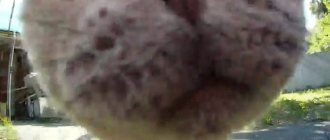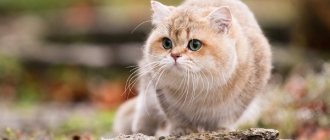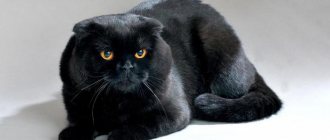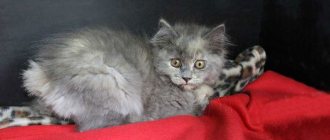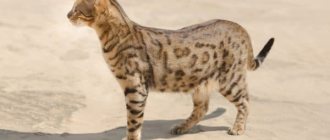The Bengal cat is one of the most ancient breeds, whose mesmerizing color of the representative dates back to the past times of the cat family. They look like animals in the wild, foraging for their own food. Many years have passed, these pets have turned into domestic cats with an attractive appearance and playful disposition.
Bengals are larger in size and weight than all other cats, their average weight reaches 7-8 kilograms. Despite their “severe” appearance, they are gifted with a sensitive digestive system, so cats must be kept strictly according to the instructions. Let's look at the basic principles of what and how to feed domestic Bengal cats.
Basic nutritional features
In the wild, Bengal cats feed mainly on rodents and marsupials. These “products” can be replaced at home with different types of meat. For this breed, it is important that at least 70% of the total portion is meat.
The raw product is more beneficial for the animal. Since the likelihood of becoming infected with parasites from eating raw meat every day is very high, it is important to first freeze the meat in the freezer for at least 5 days.
Food for animals should be as fresh as possible. If the portion for your pet turns out to be too large and not finished, it should be thrown away and not left “for later.” All dishes should be neither hot nor cold. It is necessary that the food is at room temperature. Before giving meat from the freezer to the cat, it is recommended to pour boiling water over it and cut into small pieces.
The pet must know its place for feeding, as well as meal times. It is not allowed to give any snacks in response to an animal's begging.
Bengal cats can eat both natural products and ready-made premium commercial diets. It is not recommended to combine dry food with canned food or raw meat.
Natural food
It must be remembered that the Bengal cat breed is a part of wild cats. Therefore, their diet must and first of all include meat.
The meat does not need to be boiled or fried; predatory animals love to feast on raw game.
You can also eat the hearts and stomachs of these animals.
A mandatory rule is that the meat must be frozen for at least five days. If necessary, after removing it from the freezer, you can pour boiling water over the meat. Such food should always be at room temperature and cut into small pieces.
Sometimes you can give your kitten boiled meat, but remember that it contains fewer nutrients than raw meat.
When your pet eats meat, it should make up 70% of all the food your cat eats. But, naturally, a cat’s diet can be diluted.
For example, liver (some breeds cannot have it at all) and fish can be given in small portions and rarely. However, you should not give these products more often than once every two weeks. You can also treat your pet to day-old chicks or cartilage from chicken breast. It is worth remembering that you should not let your Bengal chew bones.
If you bought chicken necks, remove the skin and grind them in a blender. By freezing such a mixture, you can serve such a dish for your handsome man (naturally, not cold from the freezer). But not all adult Bengal cats like such necks, but they are very useful for a young growing Bengal.
If you want to treat your pet to fish, then it is better not to give him river fish. Buy fillets that are boneless. It is also best to pamper a female with fish, since males develop urolithiasis faster and more often.
However, you shouldn’t pamper cats too often, because fish contains parasites. Therefore, be sure to refreeze the fish before your cat eats it or cook it.
If your Bengal cat likes quail eggs, you can give them to her occasionally. If an animal eats a boiled chicken egg yolk, then it can also be included in the diet, but not more than once a week.
Some pets love fermented milk products. Therefore, sometimes you can give your Bengal cat cream, cottage cheese or kefir (they should not exceed 3% fat content). But, some breeders of Bengal kittens believe that dairy products should be excluded from the diet.
But the cat is yours, so it’s up to you to give him fermented milk products or not. What cat breeds definitely cannot do is milk (see: Is it possible to give milk to cats). It often causes gastrointestinal upset in pets.
Other recommendations
When a kitten is weaned from its mother's breast, it is especially necessary to carefully monitor its nutrition. Typically, Bengals from three years old are fed five times a day in small portions. Its size, sexual function, activity and health will depend on a balanced and healthy diet (see size and weight of a Bengal cat).
But you shouldn’t think that if the kitten has grown up healthy and beautiful, then you can give up on its nutrition. His further appearance and well-being depend on this.
Tags
Bengal catheritage bengal catrecommended for bengal cats.for bengal catswhy the bengal breed bengal breedhistory of the bengal catrainbows of bengal catsyour bengal catfeeding the bengal catAbout the cat behind the cat the bengal cat has received masses of the cat.Bengal cats.the cat always and cats need an adult cat.the well-being of the cat after should a cat ask about kitten after kitten feeding a kitten Raising a kitten, treating a kitten
catfollowbonesmorediseasedogsotherchickenreadnoscript
Diet
As a rule, representatives of the breed are not prone to excess weight. When creating a diet, you should also not forget about the anatomically shortened intestines, which means rapid digestion of food. The optimal number of meals is calculated according to the age of the pet:
- up to 1 month – upon request;
- 1-2 months – 5-6 times a day;
- 2-3 months – 4-5 times;
- 4-5 months – 3-4 times a day;
- from 6 months and adults – 2 times a day.
A few words about care
Most new owners are constantly worried about what to feed their Bengal kitten. The peculiarities of caring for a purebred pet also raise many questions, although in fact, Bengals do not cause almost any trouble in caring for them.
The kids are playful, quickly trainable and understand all the commands of their owners. If you teach them to follow certain rules from an early age, you will get an obedient adult cat with a balanced character.
Bengals love cleanliness, so their litter box should always be thoroughly cleaned. It is best to choose wood litter, since cats of this breed love to bury their excrement and cannot stand foreign odors.
From their wild ancestors they inherited a love of water and walks, so be prepared to purchase a harness and give your pet good exercise at least once a week. Kittens love to splash and splash water, they even drink it after carefully pushing away the non-existent dirt with their paws. In this regard, children should change the drinking water in the bowl at least twice a day.
Mini leopards are great at grinding their claws off on their own, but their ears and eyes need to be kept clean. It is enough to wipe them daily with a soft cloth.
As you can see, cats of this breed do not cause much trouble, but I would like to talk in more detail about their feeding. What to feed a Bengal kitten? The question is not an idle one, because the pet’s mood and health depend on the diet. Let's look at this topic.
Breed characteristics
How difficult is it to care for the breed? | There are no particular difficulties. You need to care for your Bengal just like a regular house cat. |
Do Bengals need special food? | The diet of the breed is no different from the menu of other domestic cats. |
What size do they reach? | This is a fairly large breed. She has pronounced sexual dimorphism. Males weigh 6–9 kg, females 3–5 kg. |
Besides color, does the breed have any similarities to its wild ancestors? | Cats have hind legs that are longer than their front legs, and this gives the animal a special gracefulness to its movements. They also have a silky coat, and they have a special coat structure, as well as the “ugly duckling” stage inherited from their ancestors - phasing. |
What is phasing in Bengal cats? | Phasing is a protective gray fluff that covers the bright color. It appears at 1.5 months. At this age, in nature, kittens leave their mother's den and need camouflage. Babies of all wild cats are susceptible to phasing. |
At what age do Bengals acquire the characteristic color of the breed? | By 3–4 months, phasing usually disappears. But the color is finally formed before the age of 8. At this age, cats become sexually mature. |
Why are kittens of this breed so expensive? | The breed is not very common and difficult to breed. And breeding work requires significant financial investments. All this affects the price of kittens. However, in each litter there are more and less valuable kittens. The most expensive ones are with a phenotype as close as possible to the standard. |
Are Bengals hyperactive cats? Can they live in an apartment and not create chaos around them? | Pets can be mischievous. For them, running along window sills and jumping on the sofa is just a game. Even as they grow up, they remain kittens in temperament. But they have high intelligence. They are easy to train and quickly understand what they are allowed to do and what they are not allowed to do. |
Do Bengals leave marks in the house? | Unfortunately, animals of two sexes mark their territory. And during the period of rutting and estrus, the night calls of the sexual partner can also be heard far away. The problem can be solved by sterilizing pets. |
Is it true that Bengal cats have a special relationship with water? | Bengals love water. They enjoy playing with a stream of water, splashing water from basins left unattended. And before drinking, they instinctively rake out the non-existent algae in the container with their paw. |
They say Bengal cats don't shed. So are they suitable for allergy sufferers? | Representatives of the breed have short, silky hair. She doesn't shed much. But this does not mean that pets do not cause allergies. Moreover, for allergy sufferers it is not so much the fur that is dangerous, but the saliva and other secretions of animals. |
How does a Bengal cat behave in the house? | The cat chooses one “favorite” in the family and accompanies him everywhere. But she also loves to play with other people she knows well. |
Attitude towards children and other family members | Bengals are very sociable. They play with both children and adults. |
Attitude towards other animals, dogs | They get along well with animals. Preferred playmates are small breed dogs. They say that a Bengal is a puppy in a cat's body. |
Do Bengals need walking? | If possible, pets should be taken for a walk. They quickly get used to the harness and walk with pleasure. |
What gender should you choose a kitten as a pet? | Males are more massive than females, but females are more graceful. As for character, everything is individual. Choose the kitten that you like best. |
How long do Bengal cats live? | Average life expectancy is 12–15 years. There are also centenarians reaching their 20th anniversary. |
Advantages of the breed
- Has an extravagant appearance. This is a real indoor leopard with a good disposition.
- This is a strong, agile animal with a strong hunting instinct.
- Bengal is an intellectual. He grasps everything on the fly and quickly learns to understand his owner.
- His ability to train and remember commands is unique. This is a talented student who can be taught to perform various tricks.
- Friendliness and sociability are in his blood. Despite their physical strength, all Bengals are not aggressive. They don't bite or scratch.
- One of the cleanest animals is the Bengal cat. The description of the breed says that they have a silky coat. They take care of her themselves. Pets are bathed very rarely; as a rule, this is done before exhibitions.
- An interesting voice, not like the usual meow. The range of sounds is very wide - from simple rumbling to purring and clicking of the tongue. Owners note that these sounds resemble barking.
- Larger than most breeds. The average weight reaches 5–8 kg.
- These cats are excellent jumpers. Thanks to their elongated hind legs, they make long and high jumps of amazing strength.
Disadvantages of the breed
- The breed is considered one of the most expensive. A cat named Kato holds the Guinness Book record for being the most expensive. In 1998, a London resident bought it for 41 thousand dollars.
- The high price has led to the emergence of unscrupulous breeders who want to make money on the popularity of the breed. More and more kittens are being born with genetic abnormalities.
- Pets need physical activity. You need to walk with them at least once a week, and preferably more often.
- Socialization needs to be given significant attention. It is important to teach babies to use their hands, otherwise they will grow up wild.
- The passion for marking territory was passed on to domestic animals from their wild ancestors. Only castrated animals do not have this extremely unpleasant habit.
- The high activity and playfulness of the breed will not appeal to pedantic people who value order. Mini leopards love to run around everywhere, turning over flower pots or stacks of neatly folded things.
- They are extremely curious, interested in the contents of cabinets and chests of drawers with slightly open doors.
What to feed a Bengal kitten
Like other cat breeds, Bengal cat babies must be fed exclusively on mother's milk for the first 4-5 weeks of their lives. At this stage, it is quite enough to obtain the necessary useful elements. For the mother cat herself during this period, special ready-made premium or holistic foods are more suitable.
From the first month of life, little “predator leopards” can already try some natural products. Experienced veterinarians recommend taking thawed and chopped meat, high-quality homemade minced meat or meat porridge cooked in water as the first complementary food.
Over time, you can offer kittens larger pieces of meat. As an option, you can use delicate ready-made pates and mousses that are made for animals of this age.
The second optimal product for complementary feeding is cottage cheese. Since it can be difficult for a baby to swallow, it is worth diluting it with low-fat milk or homemade yogurt. The animal should be accustomed to vegetables last.
Bengal cats must eat kitten food until they are 8-12 months old. After a year, they can switch to adult food.
Ready-made food: tips and nuances
If you decide to please your Bengal pet with the highest quality industrial food, make sure that the label says “For kittens.” By the way, food for pregnant and lactating cats is also suitable for babies (almost identical composition to food for kittens). It’s impossible to say for sure which industrial food your baby will love. Cats, like people, have their own food preferences.
But wise intervention by the owner in the diet is mandatory. It is better not to mix different brands of food, just as you should not give ready-made food with “natural” food in the same bowl. Make it a rule: each type of food is in its own bowl.
Expert cat breeders recommend Royal Canin for any breed as a proven food. But besides this, there are several other excellent cat treats.
Dry food
- "Royal Canin Mother & Babycat" . Suitable for both pregnant cats and babies up to 4 months (although many owners successfully give this food to kittens up to 7 months of age). Special proteins and prebiotics are perfectly absorbed, and vitamins and antioxidants support the Bengal baby’s immunity. Pieces of food are easy to soak, which helps to painlessly transfer the kitten from milk to solid food.
- "Royal Canin Kitten " Recommended for kittens from 4 months to one year. Special proteins and fiber from plantain seeds take care of the baby’s gastrointestinal tract, regulate the balance of intestinal microflora and relieve problems with stool. The food is rich in vitamins and is able to fully provide energy and protection to the kitten’s growing body.
- "Sanabelle Kitten " Suitable for pregnant cats and babies up to one year old. Amino acids of the highest quality and the correct proportion of nutrients have a beneficial effect on the entire cat’s body: strengthens bones and teeth, regulates the gastrointestinal tract, takes care of the kitten’s fur and skin, and most importantly, supports its strong immunity. Experts joke that this food is so tasty and safe that the owners themselves would gladly feast on it if not for moral prejudices.
Wet food (canned)
- "Pro Plan Nutris Vour Junior" . Everything a small cat's body needs is contained in a serving of this healthy food. Omega-3 fatty acids improve vision and brain function. Calcium and phosphorus build the baby's skeleton and muscles. The balanced formula of the canned food is suitable for the first feeding of a kitten, as well as for a nursing mother cat.
- "Iams Kitten & Junior Chicken in Sause" . Canned chicken meat is great for kittens from 3 weeks to one year. The appetizing pieces in the sauce contain the required amount of all valuable substances: proteins, calcium, phosphorus, fiber, fats and vitamins. Their correct balance helps the kitten to fully develop and have a healthy, strong immune system. Canned kibble can be mixed with any other food to make your pet’s diet as tasty and healthy as possible.
List of contraindicated products
When developing a diet for your kitten, do not forget that some foods are simply contraindicated for him. These primarily include milk - it causes stomach upset. But yogurts, kefir and yogurt will become an important source of protein.
You should immediately give up potatoes and eggplants - Bengals tolerate them very poorly.
Also, don't get carried away with fish. In the wild, Bengal cats eat it extremely rarely, and therefore are not very adapted to digest it. In addition, frequent consumption of fish causes serious problems with the urinary system.
History of the breed
The Bengal cat is a hybrid of a domestic cat with a wild Bengal cat (Prionailurus bengalensis) as a result of the work of phenolenologists. In the 1960s, American scientist Jane Mill brought a wild Bengal cat from Taiwan to Arizona. Either she wanted to save a wild animal in this way (the species was threatened with complete extermination), or she simply decided to buy it as a souvenir.
In the house of an American woman, a small leopard accidentally “became friends” with a domestic cat, resulting in the birth of offspring. This is how the idea of creating a breed with the appearance of a leopard and the character of a domestic cat arose.
In 1963, Jane brought a representative of the wild species from Asia for breeding work and bred it with the American Shorthair. But in 2 litters, the males were born sterile, but wild females with domestic cats gave birth to offspring capable of reproduction.
The work was long. But she was crowned with success. For a very long time, Bengals were not recognized by any phenological association because of their wild ancestors. But in the 80s they finally got to the exhibition, where they created a sensation. And in 1991, the breed was recognized and given official status.
Natural food for an adult Bengal cat
Some owners prefer natural feeding. When preparing daily dishes for your Bengal, it is important to consider that the following products should be present in his diet:
- Meat . The optimal daily volume of meat is 60-65% of the total volume. A lack of proteins and other substances necessary for the normal development and growth of a pet occurs when the meat volume decreases to 40-45%. Pre-frozen and then scalded pieces of raw meat are ideal for Bengals - for example, chicken, rabbit, veal, chicken necks.
- Offal . With great pleasure, Bengal cats eat raw hearts, gizzards, tripe, kidneys and lungs. They, like meat, must first be frozen in the freezer and then scalded in boiling water.
- Fish . Allowed once a week. It is recommended to give preference to sea fish, previously boiled and deboned.
- Dairy and fermented milk products . Adult Bengals are happy to try cream with a fat content of up to 20%, as well as low-fat yoghurts, fermented baked milk, kefir and cottage cheese.
- Eggs . Bengals refuse boiled eggs. Therefore, the best option for them would be raw quail egg yolks. They can be given no more often than 1-2 times every 7 days.
- Vegetables . The share of vegetables in the total serving should be no more than 20%. Carrots, zucchini, beets, and sweet peppers are allowed to be given both raw and boiled.
- Cereals . They will be an excellent addition to the diet, but their norm should be limited to 5-7% of the total serving per day.
- Greenery. Added to dishes (porridge, minced meat) as an additional source of vitamins: spinach, lettuce, sprouted grass.
Natural feeding of a Bengal cat should be supplemented by periodic intake of mineral and vitamin complexes, since it is impossible to fully compensate for the lack of beneficial minerals from food.
Vitamins and supplements
When feeding with high-quality, industrial feed, vitamins and additives are not introduced into the diet. Additional sources of nutrients are necessary if you prefer natural feeding. Even the highest quality and freshest products cannot compensate for the needs of active cats.
Natural vitamin supplements:
- Meat and bone meal.
- Fish, chicken, beef liver.
- Greens, vegetables, fruits.
- Sunflower oil, olive oil.
- Brewer's yeast.
Pharmacy vitamin supplements:
- Fish fat.
- Feed tricalcium phosphate.
- Omega-3, Omega-6.
- B vitamins.
In addition to vitamins and minerals, cats need taurine. Unlike dogs, which synthesize taurine naturally, cats can only obtain this amino acid from food.
Sources of taurine:
- Turkey.
- Rabbit.
- Chicken heart, liver.
- Beef heart.
- Pork, ham, trimmed of fat, after deep freezing.
- Pork liver, heat-treated.
- Ocean fish, shellfish.
- Raw red fish.
- Homemade live yogurt.
- Whole milk.
To make life easier, the owner can conduct vitamin courses using special, industrial supplements. Vitamin complexes are sold in pet stores and veterinary pharmacies, usually available in the form of tablets or powders.
Feeding newborns and very young cats
Newborn kittens are almost never sold, because they are very difficult to care for and feed. This burden falls entirely on the kitten's mother. She will do the best job feeding a young Bengal.
The cat feeds very small Bengals
If there is no cat, but the kitten still comes to you, then you will have to watch it especially closely. You need to feed a kitten that is not even a month old with milk. Special mixtures and cat milk substitutes work well. I can recommend “KITTY-MILK” from Beaphar.
KITTY-MILK
The same powder can be used for additional feeding of kittens that feed on mother's milk. Many experts consider this substitute to be one of the best. Feed should be strictly according to the instructions.
Kittens from 1 to 4 days should be given 30 ml. mixtures per day per 100 grams of their weight.
When your pets are 5-13 days old, you can give them 38 ml. mixture per 100 grams of their weight, thereby gradually increasing the dose of nutrients.
What to feed a Bengal kitten who is two months old
Once they reach two months, kittens are fed more than just milk. An excellent option would be to start feeding him what is natural for him in nature - meat. But it needs to be prepared in a certain way, so as not to harm the kitten. At first, it is better to boil the meat, then cut it into very small pieces.
But in nature, no one cooks meat for cats, so you can give raw meat, in which case it will need to be frozen for a long time. At first, it’s better to play it safe and leave it in the refrigerator for several days or weeks. Then a thin layer is removed from the meat using a knife. The resulting shavings are doused with boiling water and given to the kitten.
Bengal at 2 months
Another good option would be porridge with meat, for example, rice. It should be given with plenty of water or milk. The finished product should resemble a thick substance.
Choosing and caring for a kitten
If you just choose a pet, the choice is made on the baby you like best. The main thing is that he is healthy. This is evidenced by clean eyes, good appetite, shiny coat, and absence of swelling near the anus. When choosing a show-class pet, there are more requirements. The baby must meet the standard. This applies to color, exterior and character.
Three types of color are considered classic:
- rosetted (roset) – spots have a light base with a dark edging;
- marbled – dark patterns on a light background;
- spotted color (spotted) with evenly colored spots on the pet’s fur.
There are also more rare colors: lynx, mink, sepia. Until recently, Bengals were dominated by warm coat tones. Today the blue color is recognized, and snow Bengal cats have appeared. Moreover, the color of kittens does not appear immediately. Only in sexually mature animals does it become as bright as possible. The new owner can only guess what color a 4-month-old baby will have. Therefore, it is important to buy kittens only from reputable breeders.
Starter kit for rehoming a Bengal kitten
It will be different in each nursery. As a rule, it includes:
- contract of sale;
- veterinary passport with vaccination records;
- pedigree or metric indicating registration in the club;
- food that the baby is accustomed to;
- toilet filler;
- recommendations for feeding a kitten.
The best ready-made diets
Having analyzed the cat food market, veterinary specialists and breeders have identified the most optimal production rations that best satisfy the needs and characteristics of purebred representatives.
- WildCat Etosha . Dry natural food from a German manufacturer. Belongs to the category of holistic products, that is, the most balanced products. It is distinguished by its high protein content (approximately 46%) and the presence of flaxseeds.
- Orijen Six Fish Cat . Canadian food based on fish products. Rich in proteins. Also includes vegetables, fruits, grain products.
- CARNILOVE Salmon for Adult Cats . This food is made by a Czech manufacturer. Created specifically for those breeds of cats that are as close as possible to their predatory ancestors. 36% consists of crude protein.
- Royal Canin Bengal Adult . Premium product from a French company. Ideal for Bengals over one year of age. 40% consists of proteins.
- Eukanuba Adult with Chicken . Quality product from the Netherlands. It is high in protein and also includes fatty acids and probiotics.
Ready-made foods are also great for small kittens, for example, from Brit Care, Fitmin For Life, Leonardo, Summit.
If the owner has opted for finished products, it is important to ensure that the pet has constant access to fresh water. In addition, the owner should not feed the Bengal with vitamins, since food from the holistic and super-premium categories contains the daily requirement of all minerals. Otherwise, hypervitaminosis will occur, which causes discomfort and discomfort in the pet.
Diet for illnesses
What to feed a Bengal cat if he has health problems? This is not an idle question, but a very important one. Bengals enjoy good health and rarely suffer from genetic diseases. However, their shortened intestines can become a problem of dysbiosis, diarrhea or constipation. In such cases, special medicated food will help, which should be prescribed by a veterinarian after examining the pet.
Medicinal food for cats with gastrointestinal diseases:
- Hill's Prescription Diet;
- Purina Veterinary Diets EN ST/OX;
- Hill's "W/D"
- Royal Canin FIBER RESPONSE FR31;
- Royal Canin Digestive Care.
Despite their natural activity and curiosity, some Bengal cats, especially neutered and elderly ones, manage to gain excess weight. Obesity worsens the quality of life of an animal and shortens its life expectancy. It is useful to switch overweight cats to food from the “Weight Control” line.
Naturally, it is necessary to decide what food to feed an obese animal only after consultation with veterinarians.
Food series “Weight Control”:
- Nutram I12;
- 1st Choice WEIGHT CONTROL for ADULT CATS;
- Eukanuba Adult Dry Cat Food For Sterilized Cats Weight Control;
- 1st Choice Mature or Less Active;
- Royal Canin Sensitivity Control SC27.
Water
At any age, regardless of the type of Bengal diet, drinking water should always be freely available in the bowl. Do not give your cat water from the tap. It contains chlorine and other chemical compounds that are unsafe for animals.
Veterinarians recommend using pre-settled, filtered soft drinking water for kittens to drink. You can also give your kitten bottled artesian water without gas.
Always wash bowls before adding water. The water is changed once or twice every knock. Make sure that there are no food particles, insects, or other third-party particles in it.
What you should absolutely not give
What to give your pet - dry food or natural food - is up to you. To prevent your animal from having intestinal problems, take note of the list of treats that you should never feed it with. The following prohibited products are identified:
- fatty meat (duck, pork, turkey). Firstly, it will be difficult for the cat to absorb. Secondly, a cat can become infected with helminths or dangerous infectious diseases from poultry;
- smoked and spicy dishes;
- sweets. This is generally taboo for the Bengal cat. From them, her teeth and fur can deteriorate, and her metabolism is noticeably disrupted;
- peas, beans and soybeans. If your pet consumes these products, bloating will inevitably occur;
- salty or peppery food. No spices, otherwise you will have to treat the cat for serious stomach problems.
Similar article: Characteristics of a samurai cat of the Japanese Bobtail breed
There are times when a cat suddenly gets sick. No matter what the cause was, treating your pet with human vitamins and medications is strictly prohibited. Otherwise, the animal’s kidneys may fail or the body may even become poisoned. Follow the key recommendations regarding feeding your four-legged friend, and he will delight you with his good health and excellent appearance.
